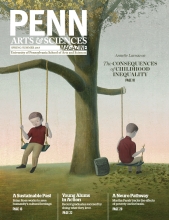Imagine a world where solar cells are so efficient at harvesting light that solar energy becomes a primary means of generating electricity.
Ramping up the capability of solar cells is just one of many path-breaking potential outcomes of the work of Assistant Professor of Chemistry Zahra Fakhraai, who specializes in understanding interactions between light and matter. Many experts in materials science, Fakhraai’s specialty, create theoretical models of structures that don’t actually exist. Fakhraai has been able not only to turn theory into practice, but to do so in three dimensions, creating new structures that are not found in nature.
To innovate in her field, Fakhraai has gathered a unique interdisciplinary team that works at the interface of physics and chemistry. Her research group includes scientists from both Penn Arts and Sciences and Engineering and Applied Science. Together, they manufactured the first 3-D nanoparticles in existence. Called “raspberries” because of their shape, these nanoparticles enable scientists to manipulate light in a novel way, and represent a breakthrough in what some scientists dub “the taming of light.” The potential applications include improvements not only in solar energy but in the diagnostic and therapeutic capabilities of medical technology.
Fakhraai’s team wrote up their findings in the article “Raspberry-Like Metamolecules Exhibiting Strong Magnetic Resonances,” published in January in the journal ACS Nano, produced by the American Chemical Society. She credits the work of Penn colleague Nader Engheta, H. Nedwill Ramsey Professor of Electrical and Systems Engineering, as providing the basis of her team’s research.
Born and raised in Iran, Fakhraai received her bachelor’s and master’s degrees in physics from Sharif University of Technology in Tehran before emigrating to Canada with her husband, a mechanical engineer. “I knew I wanted to be a physicist in eighth grade,” Fakhraai recalls. “I read an article about superconductivity and found the idea of generating electricity with no resistance really intriguing. My dream was to do exactly what I am doing now, teaching and researching at a world-class university.”
Although there are many female physicists in Iran, Fakhraai has found that in the United States there are fewer women in her field, and she does her best to advocate for young women students at both the high school and college level. She has also opened her lab to talented high school interns of both genders. She plans to do more outreach in Philadelphia to provide equal opportunity for students from a range of school districts. Fakhraai says, “I want them to know that they can enjoy math, physics, and chemistry.”



